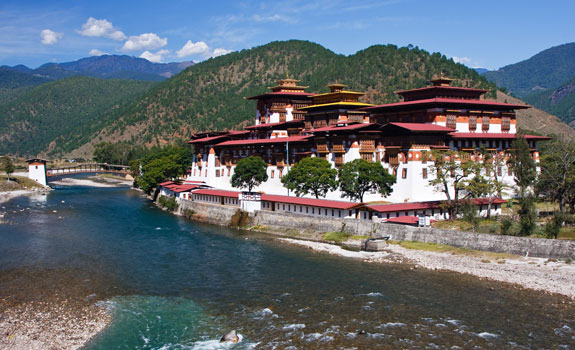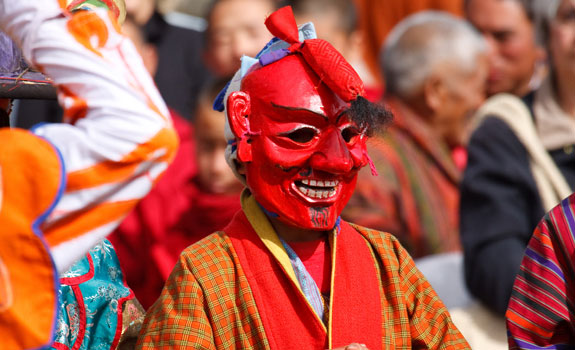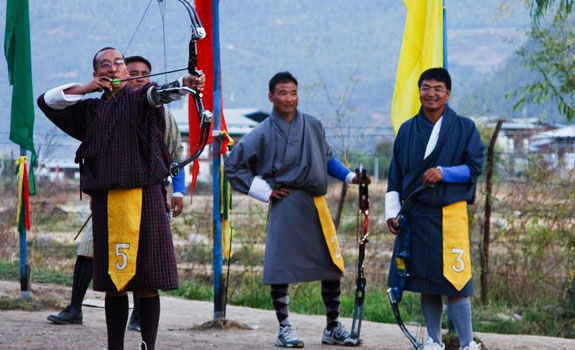1. A truly authentic experience

Bhutan is a place that reminds us of the true meaning of cultural authenticity. Tourism got here less than four decades ago. The hermit kingdom has preserved its rich cultural identity throughout years of isolation. On the streets, traditional dress remains the preferred attire and local languages Dzongkha and Sharchop can be heard. Native Dzongka-style architectural features still grace every building and Buddhism colors just about every aspect of life.
2. Taktsang Goemba (Tiger’s Nest)

Bhutan’s most famous monastery, Tiger’s Nest (Taktsang Goemba) is one of the most venerated religious sites. Legend has it that Guru Rinpoche flew to this site on the back of a tigress to subdue a local demon; later, he meditated here for three months. This beautiful building clings to the sheer cliffs soaring above a whispering pine forest. The steep walk to the monastery is well worthwhile, providing tantalizing glimpses of the monastery, views of the Paro valley and splashes of red-blossom rhododendrons.
3. Dzongs (Fortresses)

Bhutan’s dzongs are the most striking architectural feature of the country; large whitewashed forts with battered walls (inward sloping to appear larger than they actually are). They are the administrative and religious centers of authority in each region. Two of Bhutan’s best-known dzongs can be found at Punakha and Trongsa. Most distinct and magnificent, the Dzong is an architectural masterpiece with as much interest in its origin as to its functions and beauty. Fascinating myths and legends circle the Dzongs.
4. Tsechus- A colorful affair

Festivals or ‘tsechus’ are a major part of Bhutanese life and offer a unique cultural insight into this Himalayan Kingdom. Most of the dzongs and goembas have annual festivals featuring mesmerizing dance dramas. The largest of these festivals is the tsechu-with dances in honor of Guru Rinpoche. They are colorful affairs with lots of masked dancing and bright costumes where the dances take on aspects of wrathful and compassionate deities, heroes, demons, and animals.
5. Gross National Happiness

Gross National Happiness (GNH) is a truly unique and very Bhutanese idea. It is a more holistic approach to development and is drawn from the Buddhist belief that the ultimate purpose of life is inner happiness. It has been used to measure Bhutan’s development since 1972 when the fourth king proposed the idea. The assessment of Gross National Happiness was designed in an attempt to define an indicator that measures the quality of life or social progress in more holistic and psychological terms than only the economic indicator of gross domestic product (GDP).
6. Mountain treks

Trekking in Bhutan reveals a spectacular, unspoiled country steeped in ancient traditions – and with a ‘history’ that is as tall as the Himalayas. Apart from the spectacular cultural tours of the spectacular dzongs, monasteries, temples, and festivals, the best way to escape and experience more of the real Bhutan is on a trek. Explore what truly sets Bhutan apart from anywhere else and traverse the picturesque landscapes on one of the most remote kingdoms on earth on one of these wondrous mountain treks.
7. Wide assortment of flora and fauna

Bhutan has the largest proportion of land designated as protected areas in the world. Its 65% forest and mountain cover comprises a suite of varying habitats and an amazing diversity of plants and creatures. Famous for its forest cover, Bhutan will delight the amateur botanist with its sheer variety of flora and shades of green. This pristine environment is home to exotic wildlife and is the last refuge for endangered species like the Black-Necked Crane, the Blue Sheep, the Golden Langur, even the Royal Bengal Tiger.
8. Thirteen unique arts and crafts of Bhutan

The arts and crafts of Bhutan that represents the exclusive “spirit and identity of the Himalayan kingdom’ are defined as the art of Zorig Chosum, which means the “thirteen arts and crafts of Bhutan”. The thirteen crafts are carpentry, painting, papermaking, blacksmithery, weaving, sculpting and more. The Institute of Zorig Chosum in Thimphu is the premier institution of traditional arts and crafts set up by the Government of Bhutan. These art forms and handicrafts make perfect souvenirs for you that reflect rich culture and tradition of Bhutan.
9. Archery

Bhutan’s national sport of archery is exhilarating and entertaining to watch, with competitions held across the country throughout the year. There are two classes of competition: one for the traditional bamboo bows and another for the space-age-carbon-fiber bows that propel arrows at astonishing speeds. The targets seem impossibly tiny and the distance immense and yet the target is hit quite regularly. Narrow misses, competitive banter, ritual singing, and dancing accompany the whoosh of arrows and hoots of delight as the competition heats up.
10. A spiritual haven

Buddhism in Bhutan is not a religion; it is a way of life. For those who wish to embark on a spiritual journey and long for a soul-cleansing experience, Bhutan is your ideal refuge. This last Shangri-La on earth is a sacred land with deeply spiritual people. You witness the sheer cultural brilliance of this country as you submerge within the rich culture, ancient history, exquisite heritage and century-old traditions warily secured within this mystical kingdom.






